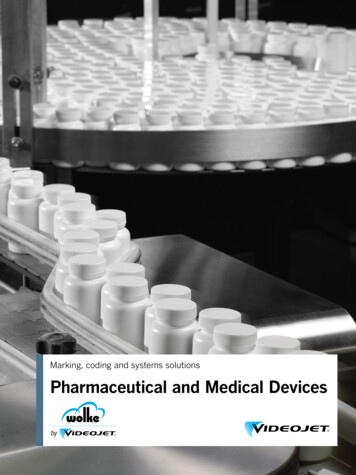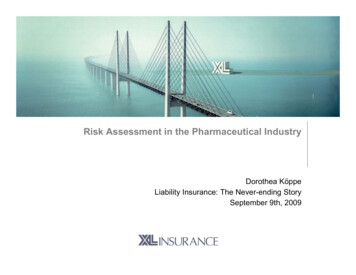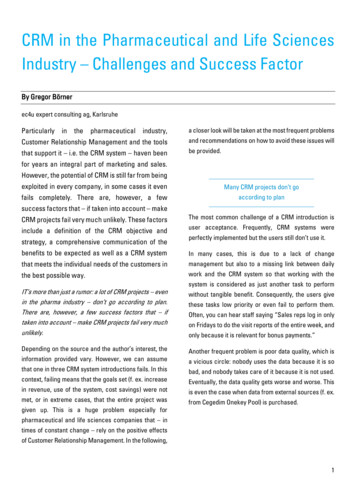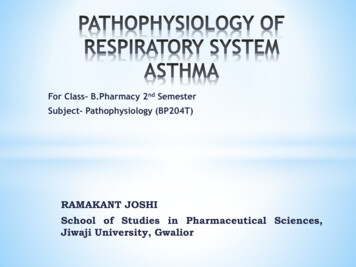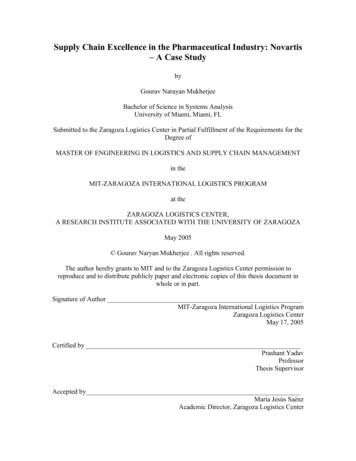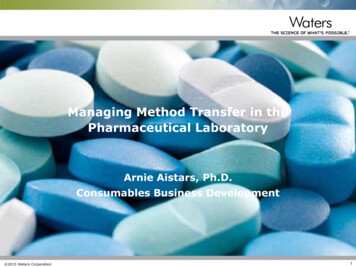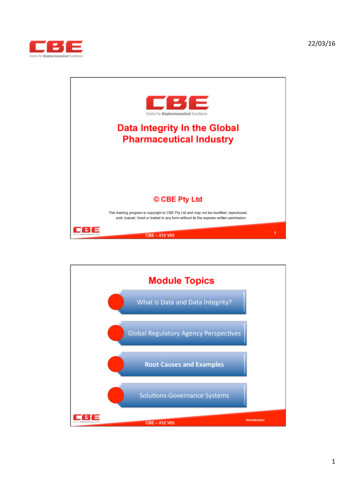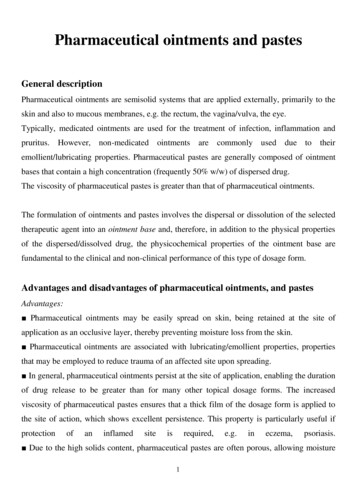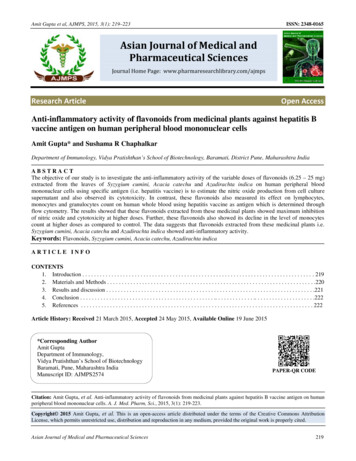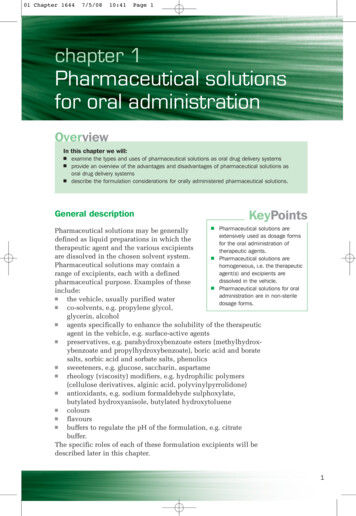
Transcription
01 Chapter 16447/5/0810:41Page 1chapter 1Pharmaceutical solutionsfor oral administrationOverviewIn this chapter we will: examine the types and uses of pharmaceutical solutions as oral drug delivery systemsprovide an overview of the advantages and disadvantages of pharmaceutical solutions asoral drug delivery systemsdescribe the formulation considerations for orally administered pharmaceutical solutions.General descriptionKeyPoints Pharmaceutical solutions arePharmaceutical solutions may be generallyextensively used as dosage formsdefined as liquid preparations in which thefor the oral administration oftherapeutic agent and the various excipientstherapeutic agents.are dissolved in the chosen solvent system. Pharmaceutical solutions arePharmaceutical solutions may contain ahomogeneous, i.e. the therapeuticagent(s) and excipients arerange of excipients, each with a defineddissolved in the vehicle.pharmaceutical purpose. Examples of these Pharmaceutical solutions for oralinclude:administration are in non-sterile the vehicle, usually purified waterdosage forms. co-solvents, e.g. propylene glycol,glycerin, alcohol agents specifically to enhance the solubility of the therapeuticagent in the vehicle, e.g. surface-active agents preservatives, e.g. parahydroxybenzoate esters (methylhydroxybenzoate and propylhydroxybenzoate), boric acid and boratesalts, sorbic acid and sorbate salts, phenolics sweeteners, e.g. glucose, saccharin, aspartame rheology (viscosity) modifiers, e.g. hydrophilic polymers(cellulose derivatives, alginic acid, polyvinylpyrrolidone) antioxidants, e.g. sodium formaldehyde sulphoxylate,butylated hydroxyanisole, butylated hydroxytoluene colours flavours buffers to regulate the pH of the formulation, e.g. citratebuffer.The specific roles of each of these formulation excipients will bedescribed later in this chapter.1
01 Chapter 164427/5/0810:41Page 2Pharmaceutics: Dosage Form and DesignAdvantages and disadvantages of pharmaceuticalsolutions for oral administrationAdvantages Therapeutic agents can easily be administered orally toindividuals who have difficulty in swallowing, e.g. elderlypatients, infants.The therapeutic agent is dissolved in the formulation and istherefore immediately available for absorption. Providing thedrug does not precipitate within the gastrointestinal tract, thebioavailability of pharmaceutical solutions is greater than thatof oral solid-dosage forms.Taste-masking of bitter therapeutic agents may be readilyachieved.Disadvantages Pharmaceutical solutions for oral administration areunsuitable for therapeutic agents that are chemically unstablein the presence of water.The poor solubility of certain therapeutic agents may prohibittheir formulation as pharmaceutical solutions. The readershould note that certain techniques are available to enhancethe solubility of poorly soluble drugs. These will behighlighted later in this chapter.Pharmaceutical solutions are expensive to ship and are bulkyfor the patient to carry due to the associated mass of theproduct.Drug solubilityIn pharmaceutical solutions both the therapeutic agent and theexcipients are legally required to be present in solution over theshelf-life of the formulated product. As a result pharmaceuticalsolutions are termed homogeneous. One of the major challengesto the pharmaceutical scientist is the attainment of homogeneityin the formulation, due primarily to, in many cases, the limitedaqueous solubility of the therapeutic agent. Initially there arepossible scenarios regarding the formulation of pharmaceuticalsolutions of a therapeutic agent for oral administration: The aqueous solubility of the therapeutic agent is high at theselected pH of the formulation. Under these circumstancesthe therapeutic agent may be readily incorporated into thevehicle and formulated as an oral solution. The aqueous solubility of the therapeutic agent is moderate atthe selected pH of the formulation, i.e. the aqueous solubilityis less than the requested concentration of therapeutic agent.Under these circumstances the solubility of the therapeutic
01 Chapter 16447/5/0810:41Page 3Oral pharmaceutical solutions agent in the formulation must be enhanced using co-solventsand related methods.The aqueous solubility of the therapeutic agent is low at theselected pH of the formulation. The difference between theaqueous solubility of the therapeutic agent and the requiredconcentration is too great to be bridged by the use of cosolvents and related methods or the concentration of cosolvents or surfactants in the solubilised formulation may betoxic when administered orally. The drug may therefore beformulated as an alternative-dosage form, e.g. a suspension.Prior to discussing the solubility of therapeutic agents andformulation strategies to modify this property, it is worthconsidering the process of drug dissolution. The dissolution of atherapeutic agent in water involves several key molecular steps:the removal of a molecule of the drug from the solid state, theformation of a cavity within the solvent and the accommodationof the drug molecule into the formed cavity. This process involvesthe breakage of solute–solute and solvent–solvent bonds(endothermic processes) and the formation of a bond between thesolute and the solvent (with the subsequent liberation of energy).Dissolution occurs whenever the Gibb’s free energy ( G) of theprocess is negative and involves a balance between the enthalpyof dissolution ( H) and the associated entropy ( S) at thetemperature of dissolution (T), as defined below: G H T SFactors affecting the solubility of therapeutic agentsThe solubility properties of drug molecules in a particular solventsystem are sometimes difficult to predict and have been reportedto be dependent, at least in part, on several physicochemicalproperties, including molecular weight, volume, radius ofgyration, density, number of rotatable bonds, hydrogen bonddonors and hydrogen bond acceptors. Furthermore, the propertiesof the solid state, e.g. crystal habit, crystalline/amorphousproperties, will also affect the solubility of the therapeutic agent.There are some empirical relationships between thephysicochemical properties and the solubility of therapeuticagents that influence formulation strategies, as follows: The solubilities of a chemically related series of therapeuticagent are inversely related to their melting points. Therefore,as the melting point of the therapeutic agent is increased, thesolubility would be expected to decrease. The solubility of a therapeutic agent is directly affected byboth the type of chemical substituent groups and thesubstituent position. The solubility of therapeutic agents3
01 Chapter 164447/5/0810:41Page 4Pharmaceutics: Dosage Form and Design containing hydrophilic groups (e.g. OH, COO , ammoniumion) will accordingly be greater than those containinglipophilic substituent groups, e.g. methyl, ethyl, ethoxy orchlorine groups.The solubilities of therapeutic agents that are either acids orbases (representing the vast majority of drug substances) arepH-dependent. The solubility of acids and bases increases asthe degree of ionisation increases and may be easily calculatedusing the following equation (where S refers to the solubilityof the drug and So is the intrinsic solubility, i.e. the solubilityof the unionised form of the drug).pK pKa logpH pKa log––( )( )S SoSofor acidsSoS Sofor basesFrom these equations two invaluable conclusions may bedrawn:At pH values above the pKa, the solubility of acidic drugsincreases.At pH values below the pKa, the solubility of basic drugsincreases.In simple terms the solubility of acidic compounds increasesas the pH of the solution is increased (above the pKa) and thesolubility of basic compounds increases as the pH is loweredbelow the pKa.Determination of the solubility properties of zwitterioniccompounds, i.e. those that exhibit both acidic and basicproperties, is more complicated than for simple acids or bases.However, in common with simple acids and bases, the solubilityof zwitterionic therapeutic agents is affected by pH. At basic pHvalues the therapeutic agent behaves primarily as an acid whereasat low pH values the molecule behaves as a base. The pH range atwhich the therapeutic agent exhibits minimal solubility liesbetween the pKa values of the acidic and basic groups.Formulation methods to enhance/optimise the solubilityof therapeutic agentsThe information described below may be employed to optimisethe formulation of pharmaceutical solutions, remembering that theprerequisite for pharmaceutical solutions is the exclusivepresence of dissolved therapeutic agent.
01 Chapter 16447/5/0810:41Page 5Oral pharmaceutical solutionsAppropriate selection of drug saltThe reader will be aware that the majority of therapeutic agentsare commercially available to the pharmaceutical scientist in arange of salt forms, each form exhibiting a different aqueoussolubility. The differences in solubility may be accredited, at leastin part, to the crystal properties of the salt, which, in turn, affectthe energy required to dissociate solute–solute bonds. Therefore,unless a specific salt form is specified or in the absence of apharmaceutical approved salt of a therapeutic agent, theformulation scientist should select the salt that provides therequired solubility in the dosage form.Optimisation of the pH of the formulationAs mentioned above, the solubility of an ionised therapeuticagent is a function of both the pKa of the compound and the pHof the formulation. Importantly, the acceptable pH range ofsolutions for oral administration is large, ranging from circa 5 to8 pH units. Therefore, a common formulation strategy involvesthe selection of a pH value for the formulation that optimises theionisation and hence solubility of the therapeutic agent. Controlof the pH in the formulation is achieved using a buffer that doesnot adversely affect the solubility of the therapeutic agent.Use of co-solventsCo-solvents are primarily liquid components that are incorporatedinto a formulation to enhance the solubility of poorly solubledrugs to the required level. In the formulation of pharmaceuticalsolutions for oral administration, aqueous solutions are preferreddue to the lack of toxicity of water as the vehicle. However, if thesolubility of the therapeutic agent renders this approachinappropriate, the incorporation of co-solvents within theformulation offers a pharmaceutically acceptable approach.Commonly employed co-solvents include glycerol, propyleneglycol, ethanol and poly(ethylene glycol), details of which areprovided in subsequent sections.Prediction of the solubility of therapeutic agents in mixedsolvent systems (the vehicle, water and the chosen co-solvent) isdifficult, due to the effects of many variables on the solubility (asdescribed previously). In practice the pharmaceutical scientistshould measure the solubility of the chosen therapeutic agent in aseries of mixed solvents to determine the most suitable solventsystem for the given purpose. The final choice of the co-solventsystem for a particular formulation involves consideration of thesolubility of the therapeutic agent in the vehicle, the toxicity of thevehicle and the cost of the formulation. Indeed, it should be notedthat the range of concentrations of each co-solvent used in oralformulations is primarily limited by concerns regarding toxicity.5
01 Chapter 164467/5/0810:41Page 6Pharmaceutics: Dosage Form and DesignExcipients used in pharmaceutical solutions fororal administrationExcipients in pharmaceutical formulations are physiologicallyinert compounds that are included in the formulation to facilitatethe administration of the dosage form, e.g. pourability,palatability, to protect the formulation from issues regardingphysical and chemical stability and to enhance the solubility ofthe therapeutic agent. Pharmaceutical solutions commonlycontain a wide range of excipients, the details of which areprovided below.The vehicleThe preferred and most commonly used vehicle in solutions fororal administration is Purified Water USP, due to the low cost andlow toxicity of this ingredient. Under normal circumstances tap(drinking) water should not be used due to the possibility ofchemical imcompatibities within the formulation. The mainfeatures of Purified Water USP are as follows: It is prepared by distillation, ion exchange methods or byreverse osmosis. The solid residue (obtained after evaporation) is less than1 mg per 100 ml of evaporated sample. It must not be used for the preparation of parenteralformulations.In the case of parenteral formulations Water for Injections BPmust be used, the specifications and use of which are describedin Chapter 5.Co-solventsAs defined previously, co-solvents are employed to increase thesolubility of the therapeutic agent within the formulation. Themain co-solvents that are used in the formulation of oral solutionsare detailed below.GlycerolGlycerol (also termed glycerin) is an odorless, sweet liquid thatis miscible with water and whose co-solvency properties aredue to the presence of three hydroxyl groups (termed a triol)(Figure 1.1). It has similar co-solvency properties to ethanol.Figure 1.1 Structural formulaof glycerol.HOOHOH
01 Chapter 16447/5/0810:41Page 7Oral pharmaceutical solutionsAlcohol USP (CH3CH2OH)Alcohol USP contains between 94.9 and 96.0% v/v ethyl alcohol(ethanol) and is commonly used as a co-solvent, both as a singleco-solvent and with other co-solvents, e.g. glycerol. The knownpharmacological and toxicological effects of this co-solvent havecompromised the use of alcohol in pharmaceutical preparations.As a result there are both labelling requirements for preparationsthat contain alcohol and upper limits with respect to theconcentration of alcohol that may be used in formulations.Propylene Glycol USPPropylene Glycol USP is an odourless, colourless, viscous liquiddiol that contains two hydro
Advantages and disadvantages of pharmaceutical solutions for oral administration Advantages Therapeutic agents can easily be administered orally to individuals who have difficulty in
